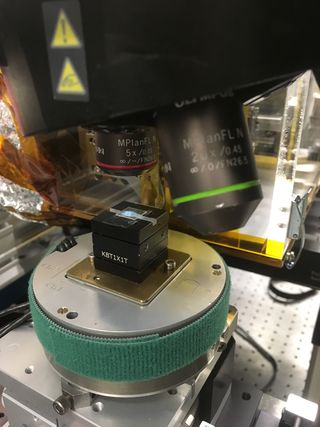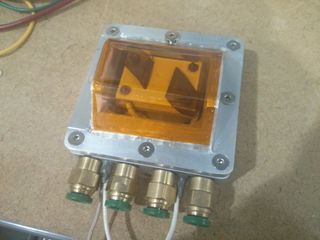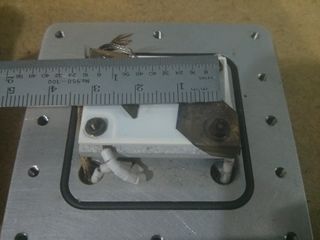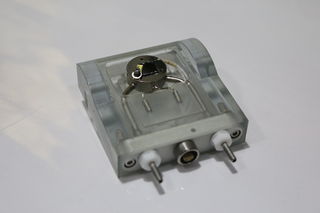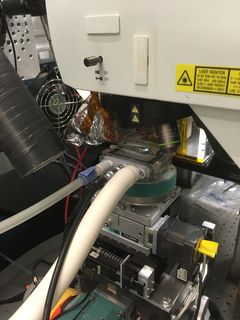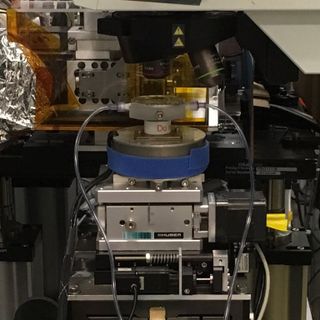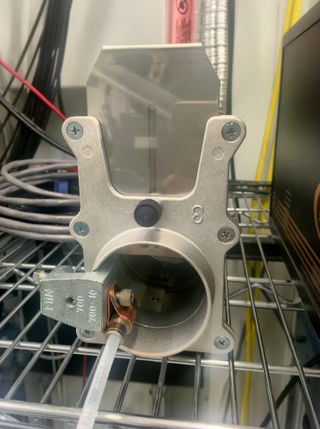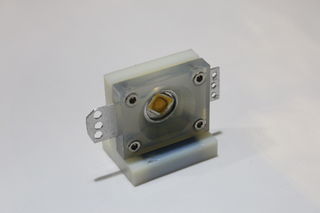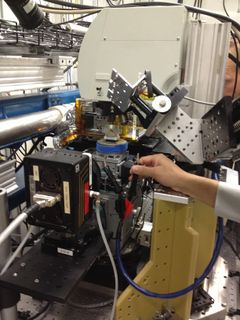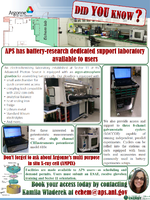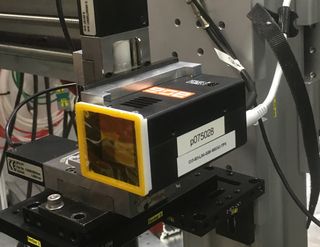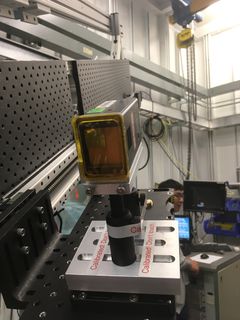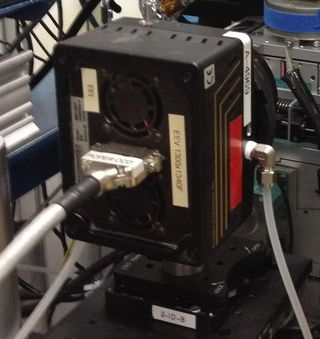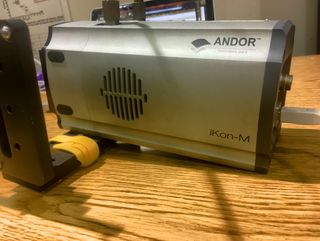Difference between revisions of "34-ID-C"
S34idcadmin (talk | contribs) (Blanked the page) |
|||
| (103 intermediate revisions by 4 users not shown) | |||
| Line 1: | Line 1: | ||
== Apply for beamtime at 34-ID-C == | |||
[https://www.aps.anl.gov/Users-Information APS Users Information] | |||
== Publications == | |||
[https://www.aps.anl.gov/Sectors-33-34/Publications/34-ID-C '''Our current publication list'''] | |||
== Setup Images and Drawings == | |||
[[Media: 34IDC_basic_instrument_diagrams_2022.pdf]] | |||
Specs: | |||
The detector arm can move in two dimensions. | |||
Delta: -2 -> 45 degrees | |||
Gamma: -2 -> 150 degrees | |||
Delta is the axis perpendicular to the floor, essentially moves the detector horizontally. | |||
The range of Delta is -2 to 45 degrees. Although it can be a little larger if the other detector axis is increased. | |||
Gamma is the axis parallel to the floor. It effectively moves the detector up and down. The range is dependent on the configuration of the instrument. It can be as much as 150 degrees. | |||
== Sample Environments (Resident at beamline) == | |||
'''Current Gas Inventory ''' | |||
Updated every few weeks. | |||
[https://docs.google.com/spreadsheets/d/1yFvu0P6Ck9RPwrFgc0DReVKp1bYSi-gFenb9BOYoTDw/edit?usp=sharing '''34-ID-C gases in stock'''] | |||
'''Kinematic Sample Mount''' | |||
The typical sample mount for STP measurements in air is a Thorlabs KBT1x1 magnetic kinematic mount. The usual fixation method is double sided sticky tape, though wax and nail polish are available. | |||
[[File:kinematicsamplemount.jpg|320px]] | |||
'''Heater Cell''' | |||
The heater cell is capable of several hundred degrees centigrade. Improvements are underway to reach up to 1000 C. It also supports gas flow through the chamber. It is not vacuum compatible. | |||
[[File:Heater1.jpg|320px]] [[File:Heater2.jpg|320px]] | |||
'''Linkam Cryo stage''' | |||
The guts of this cell is a Linkam THMS controller. Temperatures as low as -100 C are possible but since the 3D printed chamber is not vacuum compatible, icing can be significant. Development of a highly dried gas environment is underway to minimize icing. The cell can also support moderate heating, limited by melting the 3D printed chamber. We have maintained 50 C for many hours with no problem. A newer version of the chamber includes a magnetically secured removable cover. | |||
[[File:Linkam1.JPG|320px]] [[File:Linkam2.jpg|240px]] | |||
'''Liquid/Gas Flow Cell''' | |||
A small liquid flow cell is available with a peristaltic pump. A mylar or propylene film is pressed over the sample to maintain a thin liquid layer to minimize absorption of the x-ray beam. The same cell is often used for room temperature gas flow experiments. | |||
[[File:liquidcell1.jpg|320px]] | |||
'''Gas Exhaust''' | |||
A dedicated exhaust is available in 34-ID-C for experiments involving toxic or flammable gasses. The flow rate was measured to be 70 cfm (1982 lpm). | |||
[[File:exhaust718.jpeg|320px]] | |||
'''Coin Cell holder''' | |||
In-situ battery cycling is possible with a potentiostat that can be borrowed from the electrochemistry lab at APS. One can also be trained to load AMPIX cells in the echem lab. 34-ID-C also has an AMPIX cell holder compatible with the beamline. | |||
[[File:coincell1.jpg|320px]] [[File:coincell2.jpg|240px]] [[File:Echemlab.png|150px]] | |||
== Available Detectors (resident at the beamline) == | |||
'''ASI Quad (512x512) Timpix with GaAs absorber.''' | |||
This detector is our daily workhorse. The structure of the GaAs needs to be divided out of the data. We have a collection of whitefield images taken at various energies. The pixels are 55 um, can run at about 100 Hz with 11,800 ph/pixel/read. | |||
[[File:ASItimepixGaAs.jpg|320px]] | |||
'''ASI Single (256x256) Timepix with Si sensor''' | |||
The first PAD used routinely at the beamline until 2017. It's still available if a second detector is required for an experiment or the Quad fails for some reason. It can run at similar speeds to the Quad detector but has radiation damage limitations. | |||
[[File:ASItimepixSiSingle.jpg|240px]] | |||
'''Roper/PI direct detection CCD''' | |||
This was our workhorse for the first decade of the beamline. It's now used primarily for recording powder rings from battery samples during cycling. 1340x1300 with 22.5 um pixels. Runs at about 1 Hz or less reading full chip. ROI can be read faster. We only use this for CXD if we need the smaller pixels and larger area than the Andor. | |||
[[File:PIccd1.jpg|320px]] | |||
'''Andor direct detect CCD''' | |||
Used for only a couple of years, this CCD was added to the beamline just when Timepix was being commercialized. It's actually a very good CCD with low noise and relatively flat dark field background. 1024x1024 with 13 um pixels. Can read at about 3 Hz. Roughly 60 photon pixel depth at 9 keV. If we need the small pixels this detector is a goto. | |||
[[File:Andorccd1.jpg|320px]] | |||
'''[https://www.hitachi-hightech.com/hhs-us/product_detail/?pn=ana-vortex-60ex Vortex EX 60]''' | |||
Used for x-ray fluorescence this detector has recently been calibrated and can be mounted in various positions to monitor fluorescence from a sample or measure elemental composition. | |||
== Available Detectors (Non-resident but on loan with scheduling) == | |||
Additionally, there are PADs available from the [https://www.aps.anl.gov/Detectors/Area-Detectors APS detector pool]. Including Pilatus, Eiger, ASI Medipix3 and many others. | |||
== Site Access == | |||
For 2022-2 User Run starting in May 31st. 2022 | |||
APS Covid guidance can be found here: https://www.aps.anl.gov/Users-Information/Updates/Covid-Rule-Regulations | |||
1. ESAFs which require Non-ANL Onsite Users: '''Must be submitted 14 days before the ESAF start date.''' Any ESAF submitted after this date will be declined and we will ask them to reschedule or see if they can change to remote | |||
2. ESAFs with Remote or Mail-in Users only. '''Must be submitted 7 days before the ESAF start date''' | |||
3. Argonne Onsite Users: '''ESAFS must be submitted 7 days before the ESAF start date.''' If there is a mix of Non-ANL and ANL onsite users, ESAF must be submitted 14 days in advance. | |||
4. APS will be allowing for the 2022-2 run, 5 Onsite Users per ESAF. If 6 or more onsite users are required then an onsite request form must be submitted for APS approval at the time of ESAF submission. [https://www.aps.anl.gov/form/on-site-user-request-form '''User Justification Form'''] | |||
Remote/Mail-in ESAFS | |||
1. Remote site access for each remote user must be current for the experiment time frame. If it is RED in the Experimenters tab then they will have to update their registrations in the APS User database: See link below | |||
https://beam.aps.anl.gov/pls/apsweb/ufr_main_pkg.usr_start_page | |||
This should be done ASAP to allow for foreign nationals to get FAVOR approval. It will take over a week to go through the approval process for foreign nationals so please encourage them to update their registration as soon as possible. | |||
All questions about site access should be sent to the APS User Office: [email protected] | |||
Remote Users must be current in ESH223U Cybersecurity. This is an online course that can be completed via the link below: | |||
https://beam.aps.anl.gov/pls/apsweb/rt0004.intro_process | |||
Because the remote user is not coming onsite we require completion of ESH223U Cybersecurity before ESAF Approval. | |||
ESAFS will not be approved if the Remote User does not have site access or completed ESH223U (see below) | |||
1. Mail-In users. Mail-in site access must be current for the experiment time frame. ESAF system has been modified so that the Mail-in users are no longer greyed out for their site access. If they are expired in their site access it will also be in BOLD and RED. Moving forward we will ask Mail-in Users to update their APS registration using the link provided. | |||
https://beam.aps.anl.gov/pls/apsweb/ufr_main_pkg.usr_start_page | |||
All questions about site access should be sent to the APS User Office: [email protected] | |||
ESAFS will not be approved if Mail-In users do not have active site access during their experiment time. | |||
Onsite Users | |||
1. Onsite Site access for each onsite user must be current for the experiment time frame. If it is RED in the Experimenters tab then they will have to update their registrations in the APS database: | |||
https://beam.aps.anl.gov/pls/apsweb/ufr_main_pkg.usr_start_page | |||
This should be done ASAP to allow for foreign nationals to get FAVOR approval. | |||
ESAFS will not be approved if the Onsite User does not have site access. Gate passes will not be granted if the ESAF is not approved | |||
1. Training: Training for all onsite users can be done before arrival to the APS at the remote training link: | |||
https://beam.aps.anl.gov/pls/apsweb/rt0004.intro_process | |||
COVID 100 is no longer required for onsite users. | |||
Sector orientation will be completed once onsite. | |||
Additional classes can be found on the remote training link or contact the APS User Office [email protected] | |||
Please let me know if you have any questions. | |||
Nena Moonier | |||
APS Safety Officer | |||
Latest revision as of 21:34, 26 March 2024
Apply for beamtime at 34-ID-C
Publications
Setup Images and Drawings
Media: 34IDC_basic_instrument_diagrams_2022.pdf
Specs:
The detector arm can move in two dimensions.
Delta: -2 -> 45 degrees
Gamma: -2 -> 150 degrees
Delta is the axis perpendicular to the floor, essentially moves the detector horizontally. The range of Delta is -2 to 45 degrees. Although it can be a little larger if the other detector axis is increased. Gamma is the axis parallel to the floor. It effectively moves the detector up and down. The range is dependent on the configuration of the instrument. It can be as much as 150 degrees.
Sample Environments (Resident at beamline)
Current Gas Inventory
Updated every few weeks. 34-ID-C gases in stock
Kinematic Sample Mount
The typical sample mount for STP measurements in air is a Thorlabs KBT1x1 magnetic kinematic mount. The usual fixation method is double sided sticky tape, though wax and nail polish are available.
Heater Cell
The heater cell is capable of several hundred degrees centigrade. Improvements are underway to reach up to 1000 C. It also supports gas flow through the chamber. It is not vacuum compatible.
Linkam Cryo stage
The guts of this cell is a Linkam THMS controller. Temperatures as low as -100 C are possible but since the 3D printed chamber is not vacuum compatible, icing can be significant. Development of a highly dried gas environment is underway to minimize icing. The cell can also support moderate heating, limited by melting the 3D printed chamber. We have maintained 50 C for many hours with no problem. A newer version of the chamber includes a magnetically secured removable cover.
Liquid/Gas Flow Cell
A small liquid flow cell is available with a peristaltic pump. A mylar or propylene film is pressed over the sample to maintain a thin liquid layer to minimize absorption of the x-ray beam. The same cell is often used for room temperature gas flow experiments.
Gas Exhaust
A dedicated exhaust is available in 34-ID-C for experiments involving toxic or flammable gasses. The flow rate was measured to be 70 cfm (1982 lpm).
Coin Cell holder
In-situ battery cycling is possible with a potentiostat that can be borrowed from the electrochemistry lab at APS. One can also be trained to load AMPIX cells in the echem lab. 34-ID-C also has an AMPIX cell holder compatible with the beamline.
Available Detectors (resident at the beamline)
ASI Quad (512x512) Timpix with GaAs absorber.
This detector is our daily workhorse. The structure of the GaAs needs to be divided out of the data. We have a collection of whitefield images taken at various energies. The pixels are 55 um, can run at about 100 Hz with 11,800 ph/pixel/read.
ASI Single (256x256) Timepix with Si sensor
The first PAD used routinely at the beamline until 2017. It's still available if a second detector is required for an experiment or the Quad fails for some reason. It can run at similar speeds to the Quad detector but has radiation damage limitations.
Roper/PI direct detection CCD
This was our workhorse for the first decade of the beamline. It's now used primarily for recording powder rings from battery samples during cycling. 1340x1300 with 22.5 um pixels. Runs at about 1 Hz or less reading full chip. ROI can be read faster. We only use this for CXD if we need the smaller pixels and larger area than the Andor.
Andor direct detect CCD
Used for only a couple of years, this CCD was added to the beamline just when Timepix was being commercialized. It's actually a very good CCD with low noise and relatively flat dark field background. 1024x1024 with 13 um pixels. Can read at about 3 Hz. Roughly 60 photon pixel depth at 9 keV. If we need the small pixels this detector is a goto.
Used for x-ray fluorescence this detector has recently been calibrated and can be mounted in various positions to monitor fluorescence from a sample or measure elemental composition.
Available Detectors (Non-resident but on loan with scheduling)
Additionally, there are PADs available from the APS detector pool. Including Pilatus, Eiger, ASI Medipix3 and many others.
Site Access
For 2022-2 User Run starting in May 31st. 2022
APS Covid guidance can be found here: https://www.aps.anl.gov/Users-Information/Updates/Covid-Rule-Regulations
1. ESAFs which require Non-ANL Onsite Users: Must be submitted 14 days before the ESAF start date. Any ESAF submitted after this date will be declined and we will ask them to reschedule or see if they can change to remote
2. ESAFs with Remote or Mail-in Users only. Must be submitted 7 days before the ESAF start date
3. Argonne Onsite Users: ESAFS must be submitted 7 days before the ESAF start date. If there is a mix of Non-ANL and ANL onsite users, ESAF must be submitted 14 days in advance.
4. APS will be allowing for the 2022-2 run, 5 Onsite Users per ESAF. If 6 or more onsite users are required then an onsite request form must be submitted for APS approval at the time of ESAF submission. User Justification Form
Remote/Mail-in ESAFS
1. Remote site access for each remote user must be current for the experiment time frame. If it is RED in the Experimenters tab then they will have to update their registrations in the APS User database: See link below https://beam.aps.anl.gov/pls/apsweb/ufr_main_pkg.usr_start_page
This should be done ASAP to allow for foreign nationals to get FAVOR approval. It will take over a week to go through the approval process for foreign nationals so please encourage them to update their registration as soon as possible.
All questions about site access should be sent to the APS User Office: [email protected]
Remote Users must be current in ESH223U Cybersecurity. This is an online course that can be completed via the link below: https://beam.aps.anl.gov/pls/apsweb/rt0004.intro_process Because the remote user is not coming onsite we require completion of ESH223U Cybersecurity before ESAF Approval.
ESAFS will not be approved if the Remote User does not have site access or completed ESH223U (see below)
1. Mail-In users. Mail-in site access must be current for the experiment time frame. ESAF system has been modified so that the Mail-in users are no longer greyed out for their site access. If they are expired in their site access it will also be in BOLD and RED. Moving forward we will ask Mail-in Users to update their APS registration using the link provided.
https://beam.aps.anl.gov/pls/apsweb/ufr_main_pkg.usr_start_page
All questions about site access should be sent to the APS User Office: [email protected]
ESAFS will not be approved if Mail-In users do not have active site access during their experiment time.
Onsite Users 1. Onsite Site access for each onsite user must be current for the experiment time frame. If it is RED in the Experimenters tab then they will have to update their registrations in the APS database: https://beam.aps.anl.gov/pls/apsweb/ufr_main_pkg.usr_start_page
This should be done ASAP to allow for foreign nationals to get FAVOR approval.
ESAFS will not be approved if the Onsite User does not have site access. Gate passes will not be granted if the ESAF is not approved
1. Training: Training for all onsite users can be done before arrival to the APS at the remote training link: https://beam.aps.anl.gov/pls/apsweb/rt0004.intro_process
COVID 100 is no longer required for onsite users. Sector orientation will be completed once onsite. Additional classes can be found on the remote training link or contact the APS User Office [email protected]
Please let me know if you have any questions.
Nena Moonier APS Safety Officer
